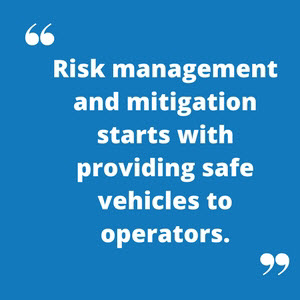Published in the September 2017 issue of Fleet Affiliation
The most recent issue of Fleet Affiliation discussed the importance of understanding vehicle certification. We’re picking up the thread with a conversation about the importance of understanding your fleet’s exposure to risk and what you as a fleet manager can do to reduce that risk.
 Although fleet managers may be diligent about important tasks and considerations such as maintenance, safety inspections, the proper licensing of operators, and record keeping, there may be misconceptions about where liability lies in the event of an incident. Risk management and mitigation starts with providing safe vehicles to operators. It is very important to ensure vehicles are properly designed for their intended tasks; to do so otherwise could result in exposing your organization to greater risk.
Although fleet managers may be diligent about important tasks and considerations such as maintenance, safety inspections, the proper licensing of operators, and record keeping, there may be misconceptions about where liability lies in the event of an incident. Risk management and mitigation starts with providing safe vehicles to operators. It is very important to ensure vehicles are properly designed for their intended tasks; to do so otherwise could result in exposing your organization to greater risk.
Provide accurate information to your upfitter
The best advice that can be given to fleet managers is to work closely with upfitters, dealers and fleet management companies. Fleet managers may believe that relying on third parties to design their vehicles reduces their organizations’ risk; they may think that because someone else designed the vehicle, then the responsibility and liability fall on the designer.
This is not completely true. Third parties have a responsibility to design trucks that meet safety requirements and are designed for the intended application. They most likely base their designs on information provided to them. It is critical to provide designers with the most accurate information on intended application, how the truck will be used, operating environments, and loading requirements. Providing inaccurate or incomplete information will most likely result in shifting liability and risk back to your organization.
More opportunities for risk reduction
Regardless of who writes a spec, whether its in-house, a fleet management company, or a dealer / OEM using pre-engineered specifications, there are four major areas that should be addressed to reduce and control risk.
- Chassis selection. Use a proper chassis; the truck cannot be overloaded for the intended purpose. This includes axles, frames, brakes, tires and springs. Keep in mind that the completed vehicle will have to comply with all FMVSS requirements.
- Vehicle upfitting. Like a chassis, it is also critical that the vehicle is appropriate for the intended purpose.
- Safety. Ensure quick access to fire extinguishers, emergency shut-offs for systems such as fuel, and hydraulic applications with proper labeling.
- Cargo. Properly secured cargo is important. Operators are notoriously creative with cargo management. Understand what needs to be transported and provide easy ways to secure cargo. This will lower your organization’s risk.
The building block of design is an understanding of the complete application of how the vehicles will be used. Provide this information to the vehicle designers; not only will this make their jobs easier, it may help result in safe, compliant, efficient and effective work trucks and reduce your organization’s risk exposure while also reducing your overall operating expense.
Learn more
NTEA member fleets also have access to our technical services division who can help them with weight distribution calculations, chassis specification issues, and other similar questions. An NTEA fleet membership is for your entire organization and is extremely cost effective. Small fleets (100 or fewer work trucks) can avail themselves of all of NTEA’s services, including engineering and regulatory questions, for only $300 per year. For larger fleets (over 100 trucks) the annual membership fee is only $600. Learn more at ntea.com/join.